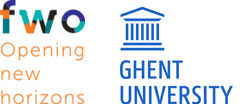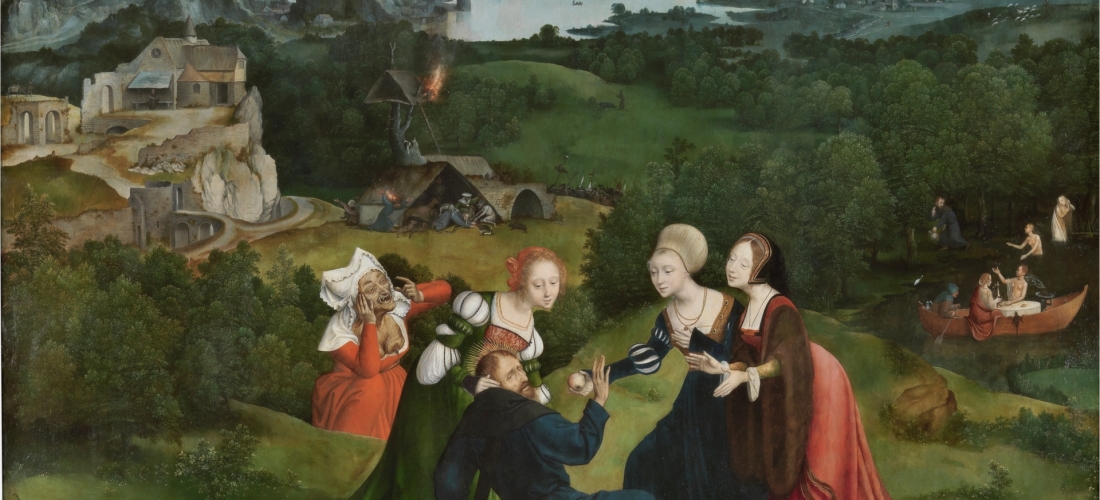In the early modern Low Countries, distinctive patterns of collaboration developed. Not only legal agreements but also relationships of trust fostered an artistic culture in which collaboration was a central practice – seemingly as important to the participating artists as to their works’ viewers. The Temptation of St. Anthony (Madrid, Prado), painted in Antwerp in about 1520–24, was described a half a century later and far from its geographical origins as a collaboratively painted work: a 1574 list of works that King Philip II of Spain sent to the monastery of El Escorial expressly described the painting as having figures by Quinten Metsijs and a landscape by Joachim Patinir.
Rubens, considered the ‘genius’ of the Flemish Baroque, is mainly associated with two types of collaborative relationships: on the one hand, as a friend and equal of other masters, such as Jan Brueghel I; and on the other hand, as the supervisor of his pupils, workshop assistants and affiliates working in other media, such as tapestry weavers, sculptors and printmakers, who executed his designs. Yet Rubens also collaborated in ways that are perhaps less often considered collaborations: his ‘autograph’ works undoubtedly benefited from dialogue with colleagues, friends and patrons; in reworking objects in his own collection, Rubens ‘collaborated’ with artists from earlier periods. Rubens was not exceptional in working so collaboratively with his colleagues, as the prevalence and variety of artistic collaboration in the early modern Low Countries attests.
Collaboration has long been a critical component of artistic practice, employed in different periods, places and media. Yet the early modern Low Countries saw particularly rich elaborations of this practice, with not only artists but also dealers and collectors involved in shaping collaborative artistic relationships, the products they spawned and how these works were viewed. This conference takes artistic collaboration to be the process of two or more individuals contributing substantively to a work’s conception and production, such that the end result is something different from what these individuals could have produced alone. A wide range of motives prompted such collaborations, and they occurred within particular historical circumstances.
Programme
5 November
- 08:30 Registration and coffee
- 09:00 Welcome: Véronique Van de Kerckhof, Rubenianum
- 09:05 Opening Remarks: Lieneke Nijkamp, Rubenianum and Abigail D. Newman, Universiteit Antwerpen/Rubenianum
SESSION I: Shaping the Image of Collaboration
- 09:25 Introduction by session chair: Tine Luk Meganck, Koninklijke Musea voor Schone Kunsten van België
- 09:40 Katharine Campbell, University of Michigan, Composite Traditions: Metsys and Patinir’s Temptation of St. Anthony and Antwerp’s Artistic Heritage
- 10:05 Dorien Tamis, Independent Scholar, The Critical Appreciation and Reception of Collaboration in the Low Countries
- 10:30 Discussion
- 10:40 Coffee break (45 minutes)
SESSION II: Structuring Collaborative Relationships
- 11:25 Introduction by session chair: Sabine Van Sprang, Koninklijke Musea voor Schone Kunsten van België
- 11:40 Jan Van der Stock, Illuminare/KU Leuven, The Antwerp Altarpiece Enterprise of Dierick Proudekin (ca. 1442–ca. 1507). Assessing the Archival Evidence
- 12:05 Rudy Jos Beerens, KU Leuven, Can't See the Forest for the Trees: Reconstructing the Sonian Forest Painters' Network
- 12:30 Discussion
- 12:40 Lunch (1 hour and 20 minutes)
SESSION III: Collaboration through Shared Knowledge
- 14:00 Introduction by session chair: Manfred Sellink, Koninklijk Museum voor Schone Kunsten Antwerpen
- 14:15 Oliver Kik, KU Leuven, Art as Science: The Art of Geometry and Netherlandish Artists’ Mapmaking Collaborations, 1480–1560
- 14:40 Ruth Noyes, National Museum of Denmark, Artistic-Epistemic Collaborations Beyond Netherlandish Art and Science: The Case of Opticorum Libri Sex
- 15:05 Discussion
- 15:15 Coffee break (45 minutes)
- 16:00 Introduction: Arnout Balis, Centrum Rubenianum
- 16:15 Keynote: Anne T. Woollett, J. Paul Getty Museum, Collaboration in the 21st Century: Then and Now
6 November
SESSION IV: Flemish Immigrants' Collaborative Strategies
- 09:00 Introduction by session chair: Eric Jan Sluijter, Universiteit van Amsterdam
- 09:15 Alice Zamboni, The Courtauld Institute of Art, Making Contact: Collaborative Printmaking in the Circle of Southern Netherlandish Artists at the Munich Court of Wilhelm V
- 09:40 Julia Grace Lillie, Bard Graduate Center, Collaboration in Exile: Print Publications by Crispijn de Passe and Matthias Quad, Made in Cologne, 1589–1604
- 10:05 Discussion
- 10:15 Coffee break (45 minutes)
SESSION V: Comparative Cases Beyond the Southern Netherlands
- 11:00 Introduction by session chair: Bernard Aikema, Università di Verona
- 11:15 Eduardo Lamas-Delgado, Royal Institute for Cultural Heritage (KIK-IRPA), Many Italian and Flemish Hands among Spaniards: Francisco Rizi and Artistic Collaboration in Baroque Spain
- 11:40 Weixuan Li, Universiteit van Amsterdam/Huygens ING, The Hands Behind De Lairesse’s Masterpieces: A Quantitative Approach
- 12:05 Discussion
- 12:15 Lunch (1.5 hours)
SESSION VI: Typical Antwerp Collaborative Techniques?
- 13:45 Introduction by session chair: Elizabeth Honig, University of California, Berkeley/Universiteit Utrecht
- 14:00 Uta Neidhardt and Konstanze Krüger, Staatliche Kunstsammlungen Dresden, Van Balen and Brueghel in Collaboration: A Group of Works from Dresden
- 14:25 Ursula Härting, Independent Scholar, Collaboration – Addition: Alexander Keirincx (1600–1652) in Antwerp, Utrecht, London, Amsterdam
- 14:50 Discussion
- 15:00 Coffee break (45 minutes)
- 15:45 Keynote: Filip Vermeylen, Erasmus Universiteit Rotterdam, Antwerp as a Center of Artistic Collaboration: A Unique Selling Point?
- 16:45 Closing Remarks: Elizabeth Honig, University of California, Berkeley/Universiteit Utrecht
7 November
- 10:00 Guided tours of the exhibition 'Baroque Book Design: A Tale of Friendship and Cooperation' at the Museum Plantin-Moretus by Dirk Imhof and Natacha Van de Peer. (Places limited to 30 participants.)
Practicalities
Participation in the conference cost € 100 p.p., €50 for students (including the two-day conference, 1 lunch on Monday and the coffee breaks).


